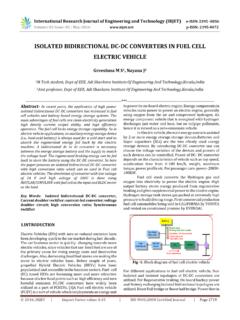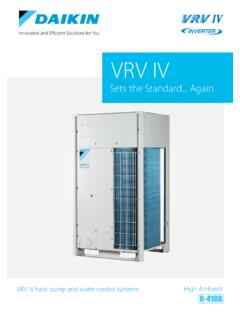Transcription of Design and Development of Electric scooter
1 International Research Journal of Engineering and Technology (IRJET) e-ISSN: 2395-0056 Volume: 07 Issue: 05 | May 2020 p-ISSN: 2395-0072 2020, IRJET | Impact Factor value: | ISO 9001:2008 Certified Journal | Page 359 Design and Development of Electric scooter Prof. Mahesh S. Khande1, Mr. Akshay S. Patil2, Mr. Gaurav C. Andhale3, Mr. Rohan S. Shirsat4 1 Assistant Professor, Electrical Department, DVVPCOE, Ahmednagar, Maharashtra, India. 2,3,4BE Student, Electrical Department, DVVPCOE, Ahmednagar, Maharashtra, India.
2 ---------------------------------------- -----------------------------**--------- ---------------------------------------- ---------------------Abstract India is the second largest producer and manufacturer of two-wheelers in the world. It stands next to Japan and China in terms of the number of two-wheelers produced and domestic sales. Indian two wheeler industry has got spectacular growth in the last few years. The face of auto industry that was redefined with the invention of fuel-efficient technology is all set to see dawn of a new era in two wheeler industry. It's not petrol or diesel or any other fuel, but it is electricity that has initiated a revolution in two-wheeler industry in India.
3 Indian two-wheeler industry has embraced the new concept of Electric Bikes and Scooters that are very popular mode of personal transport in the developed countries like America, Japan and China. So the electrically charged bikes or scooters have very bright future in area of personal transportation. This Paper studies about Design and Development and the comparison of different part of components. Also Electric two wheeler components like Battery, Charger, BLDC motor , Controller, Dc-Dc Converter explain in this paper. Key Words: Electric vehicles (EVs), Battery, brushless DC motor (BLDC), DC-DC converters, Permanent Magnet (PM), Hub motor , Miniature Circuit Breaker (MCB), Field-Oriented Control (FOC).
4 1. INTRODUCTION In recent years, environmental problems caused by fuel vehicles and fuel economy become more and more serious. The vehicles of new energy, which is green, environmentally friendly and economical, is an important goal for economic and social Development of many countries, but also the future Development direction of the vehicle. EV is a vehicle with zero pollution emissions, mileage and fuel vehicles can be mutually comparable Electric vehicles. Being an e- scooter the Electric system plays a promising role in its designing and creation. The Electric system consists of battery, motor , motor controller and other electronic equipment.
5 The most important thing that Electric system does is that it gives power to the motor which helps in the running of the scooter . This energy in form of chemical or Electric energy is stored in the battery which is used by a hub motor , thus the Electric or chemical energy converted to mechanical energy. A proper Electric system is important to ensure driver and vehicle safety in case of collision. The brushless DC (BLDC) motor is fixed to hub of rear wheel of e- scooter . The reason for choosing BLDC motor is its compactness and noiseless operation. So our main Objectives to Design or Development an e- scooter are as following:- i.
6 To reduce running cost of vehicle ii. To reduce the emissions iii. To overcome the draw backs of Electric vehicle iv. To increase life period and efficiency of existing e-scooters. 2. SYSTEM DEVLOPMENT The Key Components in Electric scooter Following are the key components in Electric scooter :- 1. Battery Charger 2. Battery 3. motor Controller 4. motor 5. DC-DC Converter 6. Vehicle Computer and Electronics The Electric vehicle is rather simple in structure. The key components are the propulsion parts. shows the configuration. Fig 1: The key components of Electric Vehicle (Powertrain) The battery is the main energy storage.
7 The battery charger is to convert the electricity from mains to charge the battery. The battery voltage is DC and current (I) is inverted into switched-mode signal through power electronic controller to drive the motor . The other electronic components in a vehicle can be supplied to the battery through DC-DC converter that step down the voltage from the battery pack to lower voltage such as 5V-20V. 1. BATTERY CHARGER In order to utilize the battery to its maximum capacity the battery charger plays a crucial role. The remarkable features of a battery charger are efficiency and reliability, weight and cost, charging time and power density.
8 The characteristics of the charger depend on the components, switching strategies, International Research Journal of Engineering and Technology (IRJET) e-ISSN: 2395-0056 Volume: 07 Issue: 05 | May 2020 p-ISSN: 2395-0072 2020, IRJET | Impact Factor value: | ISO 9001:2008 Certified Journal | Page 360 control algorithms. This control algorithm can be implemented digitally using microcontroller. The charger consists of two stages. First, one is the AC-DC converter with power factor correction which converts the AC grid voltage into DC ensuring high power factor.
9 The later stage regulates the charging current and voltage of the battery according to the charging method employed. The charger can be unidirectional can only charge the EV battery from the grid or bidirectional can charge the battery from the grid in charging mode and can pump the surplus amount of power of the battery into the grid. :- Electric circuit diagram of battery charger This is lithium ion battery charger circuit (48v 5A) for 48v 25Ah battery as shown in figure2. The circuit given here is a current limited lithium ion battery charger built around the famous variable voltage regulator IC LM 317.
10 The charging current depends on the value of resistor R2. Resistor R3 and POT R4 determines the charging voltage. Transformer T1 steps down the mains voltage and bridge D1 does the job of rectification. C1 is the filter capacitor. Diode D1 prevents the reverse flow of current from the battery when charger is switched OFF or when mains power is not available. 2. BATTERY Batteries are the components that store electrical energy, allowing for the motor of the vehicle in question to run. There is already an analysis between different kinds of batteries as seen in the below, The main materials that allow recharging are nickel cadmium, nickel zinc, nickel metal hydride, and lithium-ion/lithium-polymer, these are respectively listed as NiCd, NiZn, NiMH, and Li-ion/Li-Po on the battery analysis table.










